Rationale
To increase the density of 5 species of ungulates (and with it the Indochinese tiger population) in Huai Kha Khaeng Wildlife Sanctuary, the campaign will aim to reduce poaching of ungulates and demand and supply of ungulate meat by the local community whilst increasing reporting and enforcement of wildlife poaching and trading. Key target groups (Wild meat consumers, restaurant and food shop owners and market stall owners) will be informed of the biodiversity value of the ungulate, wildlife conservation law, and risk to health from wild meat. The campaign will aim to establish pride amongst the community of being wild meat free and creating the social norm that consumption and selling of wild meat is illegal and no longer acceptable. The campaign initiated by Wildlife Conservation Society (WCS) Thailand Program will be supported by the Public Health Unit (PHU), Department of National Parks, Wildlife, and Plant Conservation (DNP) and through a pilot wild meat certification scheme for restaurants in the Lansak Municipality and a series of workshops for restaurant owners in the entire campaign site (Lansak District). Further enforcement will be increased through the creation of a steering committee (chaired by the Mayor of Lansak Municipality and comprising the PHU, the Police, the DNP, WCS and a representative from the district Government), a reporting hotline and the creation and training of an undercover team (run by WCS Wildlife Crime Monitoring in conjunction with DNP) carrying out regular checks in restaurants across the Lansak District. The campaign will be successful if the consumers change their behavior to stop consumption of wild meat and the restaurant, food shop and market owners stop selling wild meat in their shop. Further we expect reporting and enforcement of wildlife crime to initially go up and then down and overall evidence of hunting pressure in HKK to go down.
Significant of Tiger & Prey Conservation
HKK has been well recognized among tiger conservation scientists as a key site for tiger conservation and restoration of the Indochinese tiger in SE Asia. This landscape quality for conservation of viable population of tigers has been confirmed with a photographic capture-recapture sampling revealing that HKK could hold 113 tigers at the density estimate of 3.98 tigers/ 100 km2 . It is also the most important area in Thailand for tiger prey species (ungulate) such as banteng, sambar deer, muntjac wild pig and, together with Thung Yai Wildlife Sanctuary, for gaur. It is one of the most outstanding conservation areas in mainland Southeast Asia on account of its largely undisturbed primeval forest. It contains one of the last important areas of lowland reverie forest remaining in Thailand, which supports the last viable populations of several riparian bird species in the country. These include green peafowl, lesser fishing eagle, red-headed vulture and crested kingfisher. The combined area may be the only conservation area in Thailand large enough to offer long-term prospects for the survival of many large mammal species.
Threats in HKK include hunting, habitat conversion, and non-timber forest product (NTFP) collection. Over two years of the new patrol system in HKK reveals that people living near the sanctuaries are the source of different threats to wildlife especially tigers and their prey. Among threats, poaching of tiger prey including the sambar, gaur, banteng has seriously depleted food supplies for tigers in many areas. The cause of hunting is mostly for selling wild meat to local wild meat restaurants located outside the protected areas with large ungulates and primates as the main targets. Although selling of wild meat is illegal in Thailand the underground business is still going on in many local restaurants. In 2007-09 the data from the survey of wild meat food shops and restaurants in 3 districts next to HKK reveals that there are 13 out of 67 food shops (about 20% of total checked) that are likely to sell wild meat. (WCS 2007)
HKK does not have any villages inside its boundary but along the eastern side of HKK are 29 villages located within three kilometers from the sanctuary boundary. All of the village areas cover 3 Amphoes (district) are Lansak , Huai-kot and Banrai, 7 Tambon (sub-district) are Rabam , Po-oa, Thaonlang, Kokkawa, Chaowat , Kanmakrut and Banrai. In the population of 29 villages, there are about 4,589 household, with about 17,500 people. (Word Heritage Site Conservation Office 2008)
Almost all of people in the area basically live off the agriculture lands out side the protected area. Majority of people earn a living off the agriculture such as plant crops such as corn and cassava. Also, they farm domesticated animals such as cattle, buffalo, goat, chicken and duck. (Word Heritage Site Conservation Office 2008). A survey conducted by Ministry of Agriculture and Cooperative in 2007 estimate the average income for household about 50,619 Baht / year (about 1,488 USD/year)
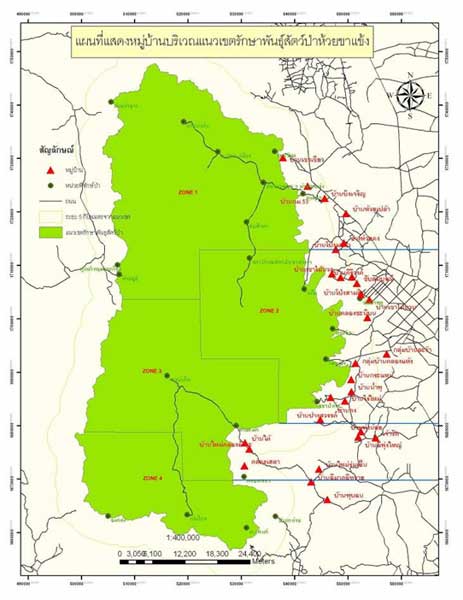
Map of HKK boundary, adjacent to communities
in Lansak, Huaikod, and Banrai District, Uthaithani Province
Target Areas
Campaign primarily focusing only Lansak district area which is the north part of HKK area. It's cover 6 sub districts which are Lansak , Pa-o, Rabam, Thung na ngam, Nam rob, Praduyuen and 1 Lansak Municipality. In Lansak district, there are 81 villages, comprising about 9,022 households with around 57,834 people.
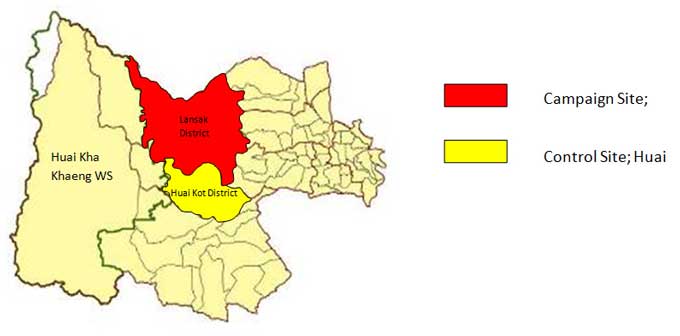
Target Audiences
For the Pride campaign activities, we aspect 3 groups of target audiences as following:
1. Community members, including teachers and students in the totally 20 local schools in Lansak district
2. Restaurants and Food Shops owners
3. Market Stalls owners
Objectives
The principal objectives of the project is to increase the density of 5 species of ungulates (and with it the Indochinese tiger population) in Huai Kha Khaeng Wildlife Sanctuary, the campaign will aim to reduce poaching of ungulates and demand and supply of ungulate meat by the local community whilst increasing reporting and enforcement of wildlife poaching and trading.
Progress Report
The pride campaign is show to have causal impact on each of the behavior change stages: knowledge, attitude, Inter Personal Communication, Barrier Removal, that the market stalls owner pass through on their way to the adoption of a new behavior, stop selling bush meat in there shop. The preliminary objective for food shop, restaurant, and market stall owner can lead threats reduction to the principal conservation result. The activities progress following the preliminary objectives are in 2 sections:
1. Campaign Materials Activities
2. Community Outreach & Mass Media Activities
Campaign Materials Activities
1. Mascot
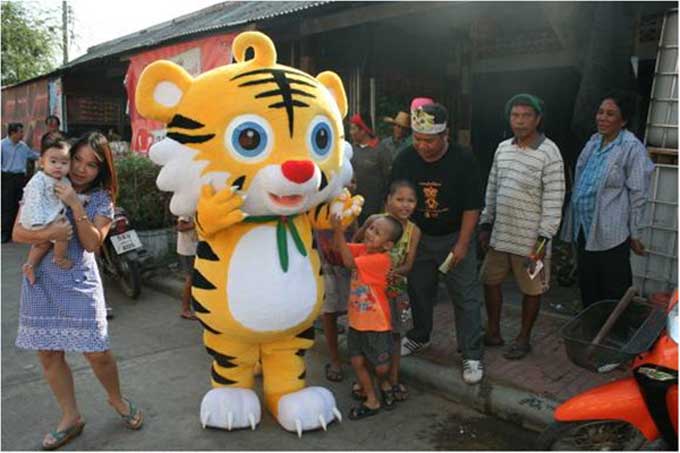
The mascot makes a campaign recognize and familiar with people, as well as to help motivate people for tiger and prey conservation.
2. Apron and chef hat for restaurant and food shop owner
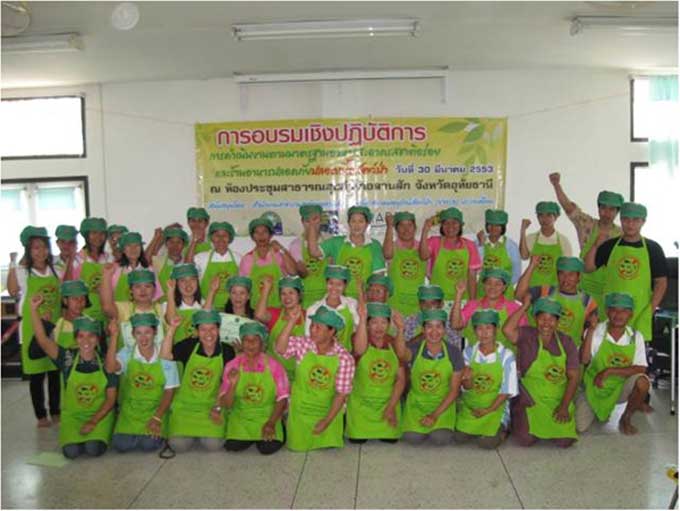
300 sets of aprons and chef hats designed and distributed to restaurants and food shops participating the project, aiming them to deliver the message to one another about stop selling wild meat as screened: "Best Thai Food no need wild meat/ No wild meat in our shop"
3. Billboard
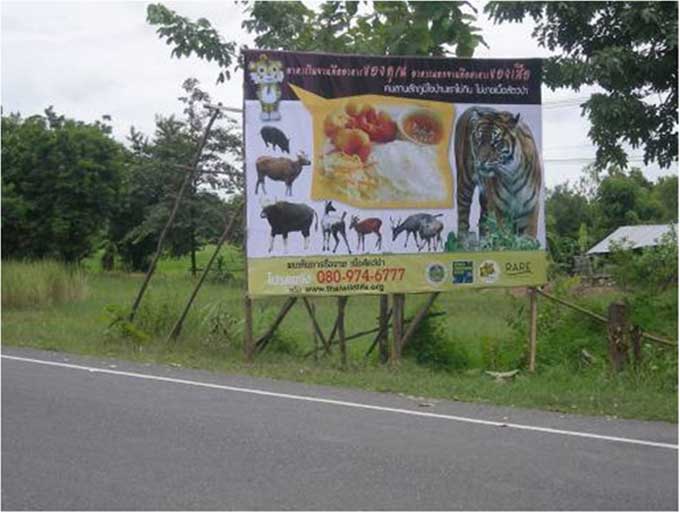
The 25 position of billboards displayed to urge for an action and to provide hotline number and the reporting website in case any local people detect some selling or buying action of wild meat.
Message :
(Slogan)
"Food on the dish is your food but out side of dish is the Tiger prey."
"Proud of Lansak No wild meat eating and selling in our area."
(Notification)
"Detecting of wild meat trade,
Please report to 080-974-6877 or www.thaiwildlife.org"
4. Bumper sticker
2,000 bumper sticker designed and distributed to people in the target area performing project's logo, hotline number, and slogan:
"Buying and selling wild meat are illegal, help reporting whenever you see."
5. T-shirts
300 T-shirts designed and distributed to campaign volunteers and general consumer delivering the message of not selling and buying wild meat in Lansak district and to report to the official concerns in case of illegal actions detected.
The T-shirt especially made for the volunteers and staffs was to wear on a parade at Lansak municipality area on 25 of March 2010.
6. Legislation Posters
Altogether 3,000 pieces of poster in 3 designs are printed and distributed to the target audience delivering :
(Message)
"Selling of wild meat is illegal, help reporting whenever you see. Bring the punishment for illegal poaching."
(Slogan)
"Help save the tiger by stop eating and selling the tiger prey meat."
"Proud of Lansak No wild meat eating and selling in our area."
7. Fashion Button
Altogether 3,000 pieces of decorative fashion buttons in 10 designs created by a famous cartoonist showing mascot & tiger prey picture with the campaign slogan. They were produced and distributed to target audiences and especially children.
(Slogan)
"Proud of Lansak No wild meat eating and selling in our area.
8. Tiger paper craft model
1,000 sets of tiger paper craft model was apply from the Japanese books by cat model to tiger model, enhancing the children learn and play with love to the tiger.
9. VCD Learning
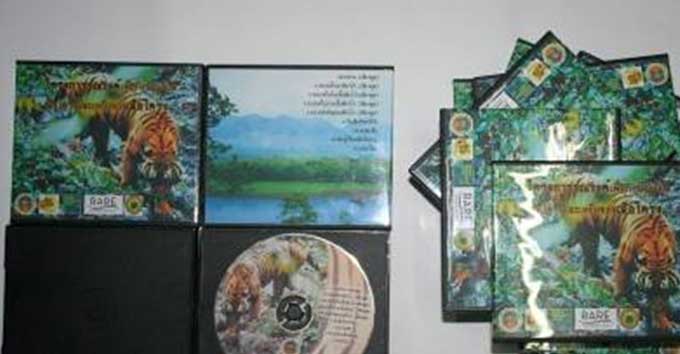
The VCD includes the campaign spot, represent the information and story about tiger and prey prepared and distributed totally 200 sets. The cover designed by HKK education center.
Community Outreach & Mass Media Activities
1. Campaign Parades
The 1st campaign parade set up on 25th February 2010, as 1 round walked along the local market road of Lansak district. The parade sponsored by many organizations in Lansak district. Approximately 1,200 people joined the parade train, comprising children from 50 schools, 30 government officers and other interested people were volunteered. Media publication such as posters and stickers have been distributed to general people, as well as local food shop, restaurant and market stall owners.
The 2nd campaign parade set up during 31st August - 1st September 2010, as a part of Seub Day 2010 in memorable of Seub Nakhasathien. The governors and Director General of Department of National Parks, Wildlife and Plant Conservation (DNP) came to join. 300 people and 300 students walked along with campaign banners with exhibition and activities organized at HKK WS on September 1st. Approximately 1,000 people joined the parade train, comprising 800 school children and 200 people. The campaign parade together with other activities seemed highly influence people to change their attitudes toward tiger and prey consumption to those of conservation, and to understand how significant of stop eating tiger prey is.
2. School Visits
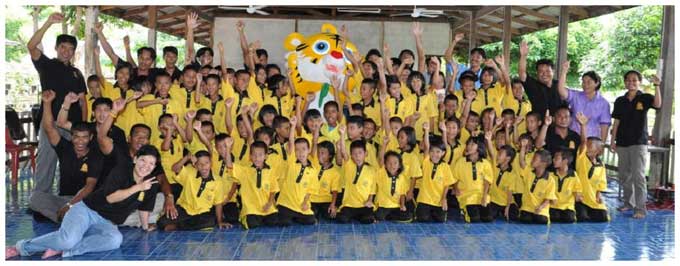
In cooperated with Nature Education Project, the one-day visit taken for teachers and students with many learning activities prepared for kids such as game, VDO, quiz, as well as souvenirs and distributing materials. The mascot did a great job with kids.
The school visit activities held for 20 schools in Lansak district with approximately 1,500 students attended.
3. Public Health Volunteers Network
The volunteers are representatives form each villages in the district. After they have the information and understand the campaign goal, they can give the message to other people in their villages. The volunteer helps distributing the campaign materials to general consumer and food shop as well as the market stall owners in their villages.
The public health volunteers network meetings were taken place during April - September 2010 for altogether 6 times in 6 sub-districts with altogether 10 teams of around 1,200 participants.
An observation study trip held once for the representatives from each team during 29th - 30th July 2010 at HKK WS.
4. Study Trip for Community Leaders
A study trip was held in 20th - 21st July 2010 for 26 village leaders form 12 villages around HKK buffer zone. The community leaders help distributing the campaign materials to general consumer, food shop and market stall owners in their village.
5. Teacher for Tiger Training

In cooperated with Nature Education Project, a training course for teacher held during 4th - 5th and 12th - 13th June 2010 at HKK WS before the occurrence of school visits. It is aim to prepare the teacher to be able to handle games and quiz as well as to use tools and materials including TFT manual with children.
Total 30 teachers from 20 local schools had participated the trainings. And after the trainings completed, the teachers are ready to support school visits with their own students.
6. "Best & Safe Restaurant - Without Wild Meat" Activities
Through this activity, the food shops and restaurants in Lansak district were inspected by the public health team in 5 times on February to September 2010 for 15 shops and 3 times on April , July and September 2010 for 15 shops. The owners of food shop and restaurant gave a very cooperation and the inspection result revealed no any wild meat detected.
The inspection committee consists of representatives from various agencies in the area which related to the project. It has a good cooperation from everyone. This committee acts follow and advice on the restaurant and food shop inspection in the project.
7. Restaurant and food shop owners workshop
At Lansak Public health unit office, the 1st workshop held on 30th March 2010 with 70 participants, and the 2nd on 31st March 2010 with 30 participants from restaurants and food shops in Lansak district area.
The session has a good cooperation from restaurant owners. They are interested in the content of the project and cooperation to promote campaign materials on the shop and also willing to take the apron to promote as a wild meat free restaurant. They offer participation on wildlife meat inspection at their restaurant following the program.
8. Radio Spot & Program
"A Call From Huai Khakhaeng" local radio program on air through FM 103.75 MHz (Community radio) / 1hr per day / 5 days per week / on air during 4 pm - 5 pm on Mon-Fri / period: 4 months form June to September 2010.
The station reaches 5,000 people in average. In estimate, 1,000 people heard each day. Through the program, local people can call to talk with the DJ and ask information about tiger conservation and wild meat trade as on air Q & A activity.
The radio spot & program are supported by the radio station for free with spot opened 7-10 times per day.
9. Comic Camp
With collaboration of Thai Cartoonist Association, a cartoon drawing camp held on 10th - 13th August 2010 at HKK WS. Total 33 children participated with 8 teachers and cooperated by 16 DNP staffs.
The drawing camp helped the children understand about tiger and tiger prey conservation with the norms of not eating tiger prey meat and to report to hotlines for illegal action. The children's creative drawings have been awarded and also being used in the design of the legislation posters.